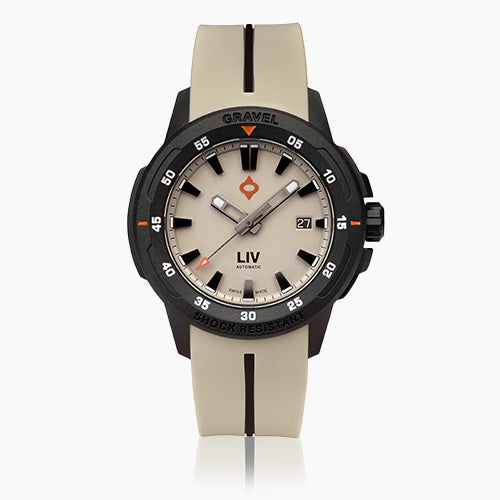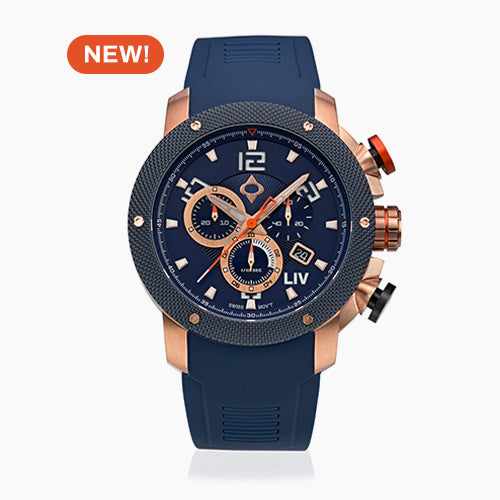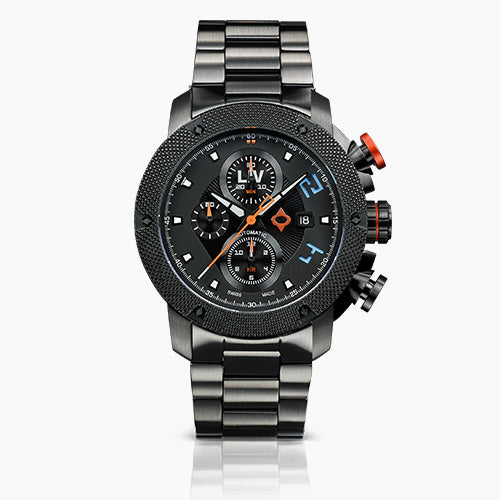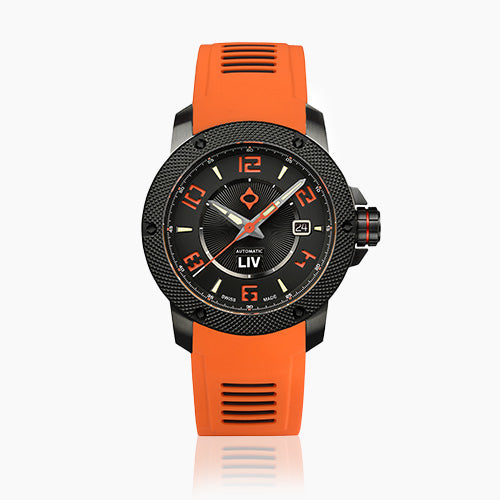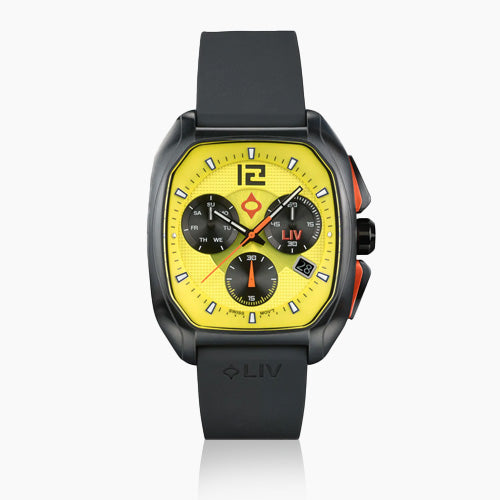
Watch Vocabulary Starter Kit
Share
"Just the facts, ma'am."
For anyone born in the second half of the last century, the famous line from "Dragnet" noted above became synonymous with keeping it simple and succinct. For this terminology article, I am going to keep it simple and basic, in honor of Jack Webb's character, Sgt. Joe Friday. The emphasis is going to be on the terms you'll encounter most frequently as you build your watch collection.
But, before we dive in too far, I want to provide the etymology of the word horology.

Horology is, simply put, the science of time. It is a modern word coined in 1792 from Greek hōra, or "part of the day; any period of time" (see hour) + -logy.
Prior to 1792, the word was used to mean "clock, clock dial" (c. 1500), in which sense it represents the Latin horologium, "instrument for telling the hour" (in Medieval Latin, "a clock"), from Greek hōrologion, "instrument for telling the hour" (a sundial, water-clock, etc), and from hōrologos, "telling the hour."

The word horologiography is not a typo, but refers to the art or study of watches and timepieces, while horology is the study of time itself.
Now, let's begin.
Barrel - The circular component in a movement that holds the mainspring. The barrel is fitted with a gear to engage the rest of the drive train.
Base plate - The main structural element of the movement. The gears are mounted on axles that fit into holes on the base plate. When combined with other structural elements such as the bridge, this keeps everything together.
Bezel - A circular portion around dials and subdials that contains information useful for telling time. Similar to chapter rings (see below), bezels on the outside of the case surrounding the crystal. The most common use is to track elapsed time. They are marked with the hours, and the user gauges how much time has elapsed by noting the hand position relative to the bezel's markings. The more functional type of bezel for this purpose is the uni-directional rotating version. Here you rotate the bezel so that the 12 marker is aligned with the hour or minute hand. This makes it much easier to keep track of elapsed time. For this reason, it is popular on dive watches.
Big date/grand date/large date - a complication featuring a display of the date of the month in a format other than a small single window in the dial, usually between the 3 and 6 o'clock position. Big dates can be displayed in a single or double window. They can be a single dial or a double dial (one displays 0-9 and the other 0-30. These windows are most frequently placed at either the 12 or 6 o'clock position, although watchmakers are free to get creative.
Caliber - Another name for the watch movement. Think of it like the movement's model number. For example, the LIV GX Diver uses an ETA caliber 2824-2.
Case - the container for the watch's movement. Most commonly round, it also comes in a wide range of shapes. Before assembly, the case looks like a donut with a huge hole in the middle and some twiddly bits called lugs on the outside at the 12 and 6 o'clock positions.
Case back - The cover on the side of the watch against your wrist. It can be plain, engraved, laser-etched, or sport any number of other embellishments. The primary purposes of the case back are to protect the movement from damage due to dirt, water, and other environmental contaminants. Also, it can be used to convey basic information such as:
- Movement model number
- Serial number
- Model name
- Manufacturer's name
- Limited edition information

Complications - functions provided by the watch movement beyond the display of hours and minutes.
Crown - The knob on the side of the case that you use to set time and wind the mainspring. Where did the name "crown" originate? I'll admit to using my understanding, which is because it can look like a crown. Also, it crowns the pocket watch, the predecessor of the wristwatch. The Crowns on watches can be very ornate, or they can be simple.

Dial - The "face" of the movement. Here is where watchmakers express a different aspect of their artistry. From a flat, white dial to one with elaborate pressed finishes and multiple levels, the dial possibilities are practically limitless.

Flyback or retrograde - This complication typically uses a hand to indicate the passage of something, say the day of the week. The days are typically arranged in an arc. As each day ends, the hand moves to the next. On the last day, the hand snaps (of flies) back to the start position.
Furnace blue screws - Some watches have beautiful blue screws securing parts of the movement. These are called furnace blue because the color is imparted by treating the screws in a furnace. Some watches also use this process for the hands. There is also more to bluing than simple cosmetics. Some screws become brittle when manufactured. Bluing is a heat-treating process that makes the screw softer. Softening a screw may seem counterintuitive, but it is done to minimize the risk of damage to the screw during assembly and repair. Ever broken a screw? Then you know how hard they can be to remove. Image attempting that rescue on a watch movement with its miniature screws.
Gear train - This is the series of gears that provide the various timekeeping functions of the timepiece. From the back, you will see just a few of the gears.
Geneva striping, Côtes de Genève - A pattern of parallel stripes applied to movement components like perlage.

Jewels - Where the reduction of friction is especially important in the movement, the watchmaker will insert rubies into the holes in the movement plates. Ruby has very little drag, so is a perfect material for this job. You'll recognize them as tiny red circles on the base plate. Don't get too excited about rubies in your watch. Today they are synthetic.
Lugs - The four protrusions on the case at the 12 and 6 o'clock positions (usually). These provide the mounting point for the watch bracelet or strap using screws or spring bars.
Mainspring - This is the power source for mechanical watches. The spring is wound by hand or a rotor. As it unwinds, it powers the gear train, which converts that energy into the display of time.
Master calendar - The sky is the limit when creating a master calendar. A variant of the venerable ETA Valjoux 7750 is the 7751, which is a basic master calendar. This movement displays the day of the week and month of the year in two windows, usually at the 12 o'clock position. There is a Moon phase or day/night display at the 6 o'clock position, and the day of the month is indicated around the chapter ring with the 31st at the 12 o'clock position as well. A special hand with a crescent on the end indicates the day of the week. You may think this is more than a basic master calendar. Well, in horological terms, it is pretty basic. Other watchmakers offer the year, actual phases of the Moon, and a range of astronomical data. These movements can command six figures or more.
Minute repeater - a complication that chimes the time for you at the push of a button. Counting out hours, quarter-hour, and lastly, minutes. Back in the days before tritium and Super LumiNova-style luminescence material, to tell time after dark required a light source. In high society, this might be awkward if you were attending the opera or some other artistic endeavor. It would be unseemly to strike a match to see how the evening was getting along.
Moon phase - a complication that shows the phases of the moon. When a watch has a true Moon phase, you will see the Moon as it waxes and wanes, or is that wanes and waxes? It doesn't matter; the Moon shows its face behind a cut-out in the dial, most commonly at the 6 o'clock position. As the Moon advances through its phases, the edges of the cut-out reveal and then block the face to mimic what you see outside. This complication is fairly rare because of the difficulty in creating the movement. What is most common and is often mischaracterized as a Moon phase is the day/night indication. Visually, it resembles the Moon phase. The distinction is that, during the day, you see happy old Sol. At night, you'll see the Moon. A cool complication, but beware, don't pay a premium to get a Moon phase when it's a simple day/night indicator.
Movement - what converts spring or battery energy into the display of time. Movements can be mechanical (manually or automatically wound), quartz, hybrid (combining elements of the first two types), and electronic, a.k.a. Smartwatches. The following definitions apply to mechanical watches. Some quartz will have a few of the same bits.
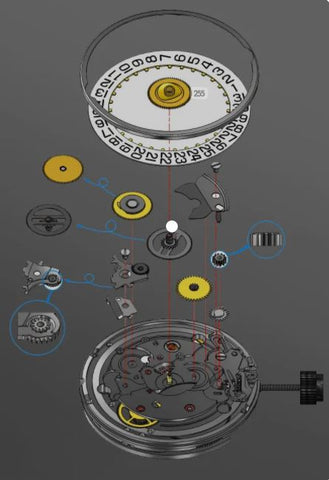
Perlage - A pattern of small overlapping circles applied to the structural components of a watch movement and other surfaces like the rotor. The pattern is created using a rotating wooden peg.
Pinion gear - This part is a shaft with a gear attached. The gear engages other parts of the gear train. As the gear train moves, the shaft rotates, powering watch hands and other parts. A common name for the pinion that powers the hours, minutes, and seconds hand is cannon pinion.
Power reserve - this complication is the "gas gauge" of automatic watches. Like a flyback complication, a hand indicates how much power the watch has left before it stops. The most common markings are in hours.
Skeletonization - When a watchmaker skeletonizes a watch, they remove as much of the material from the movement as possible without weakening the structural integrity of the watch. Skeletonized movements usually receive additional engraving, and the gears and other components of the movement may be upgraded appearance-wise now that they are visible. Dials are optional for this complication, which requires installing the indices differently.
Subdial - A smaller dial on the main dial. These are used for a variety of purposes, such as displaying elapsed time in chronograph watches, day of the week, day of the month, moon phase, and more. They can be recessed or flush with the main dial, depending upon the effect the watch company wants to create.

Tourbillon - The pinnacle of horological complications is the tourbillon. Think of it like a gyroscope where the escapement is isolated from the rest of the movement in a manner that almost eliminates the effects of gravity on the watch. Hold a tourbillon at any angle, and it will not skip a beat (pun intended) because of gravitational forces.
Winding shaft or stem - A threaded rod with the crown on one side and a gear or two on the other to engage the gear train to set the time and wind the mainspring.
Wrapping up
Well, you made it to the end! Congratulations. You are now in possession of an excellent working vocabulary for watches. I couldn't possibly have provided a complete list, at least not without quitting my day job, something my CFO (aka, wife) wouldn't countenance. As you expand your watch collection and dig deeper into the horological world, you'll add more in no time.




